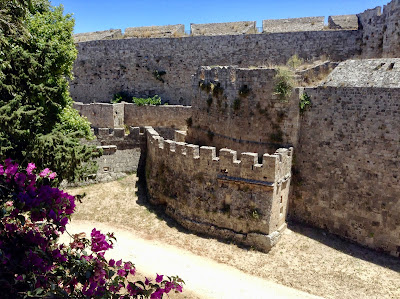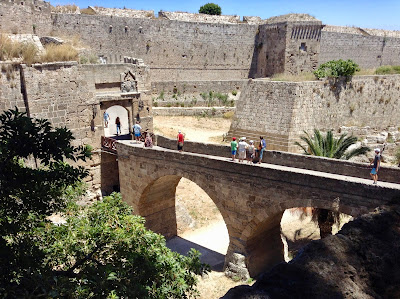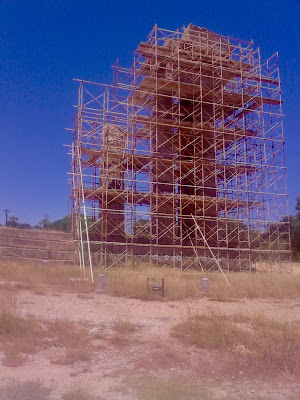It's a bit hot to be honest. OK, so from here on in until probably mid-September we expect it to be uncomfortably warm, but even Sakis the TV weather man (may his name be blessed) has given a heatwave for Greece this weekend, especially the Dodecanese Islands, with temperatures expected to be around 44ºC on Saturday. Phew. We had 41 under our car port yesterday already.
In fact, I had occasion to be driving home from Kalathos a few hours ago, at just after 11.00pm in fact, and the outside temperature was reading 35ºC on the car's instrument panel. 35ºC at 11.00pm, now that is unusual - and very uncomfortable too.
Mind you, since I have the 'Bay to Bay' excursion to do on Sunday, apart from the two hours we'll spend in Stegna, where it's always sweltering in July and August, it'll be a relief to be at sea all day. I took this shot below BTW just last Sunday after we'd returned to St. Paul's Bay at 4.00pm. The boat toward the left is our valiant little vessel for the day, the Madelena. She's not quite your Tom Conti boat from Shirley Valentine perhaps, but she isn't one of those modern steel super-structured things either. In fact she endears herself to every guests who comes on the trip by the time we get back at the end of the voyage. She does have a charm that grabs you as the day progresses.
 | |
|
What I'm really chuffed about tonight though, is the fact that as I was driving up the lane to the house I had the best view of a badger one could ever wish for. From the 'kentriko dromo' [main road] up to the front gate along our dirt lane is exactly one kilometer. It's slightly less as the crow flies, but when you drive it you go through quite a few twists and turns, thus making it add up to the 1k. The wildlife we've seen along this lane over the years is truly amazing.
In winter time we constantly encounter deer, in summer I've lost count of the number of hares that seem intent on bounding along the lane in front of the headlights for quite a while before realising that they only have to swerve to the left or right and they'll be safely out of harm's way in the undergrowth. Someone told me that they're dazzled by the lights, since they see much better in semi-darkness. That might make a bit of sense.
At certain times of the year we've seen nightjars 'crouched' down in the dust, looking just like a piece of wood until they decide that we've come just close enough and then they take to the air. Of course those long black snakes will sunbathe on the lane in daylight and the chukars will often run comically in front of us until they take to the air, almost reluctantly, before skimming low over the shrubs and bushes as they make their getaway. Just the other night, as I walked the drive at 3.00am, I saw a polecat or something like it trotting along the lane nonchalantly right past our garden gates.
But that badger tonight, well, that's left me feeling chuffed to bits. We've seen them rarely over the years, but never as well as the one I saw tonight. He (or she) was walking along the lane toward the car as I drove toward it, when it casually turned to one side and walked on to the area of dried grass beside the lane, where, once it had put about six feet between itself and the edge of the lane, it stopped, turned sideways and watched me drive past. Call me a simple chap, but that gave me a tremendous thrill.
What was also rather appropriate though, in view of the fact that we have a large rubber tree in the garden not a stone's throw from the jacaranda in the orchard, and my latest non-fiction book is called "A Jay in the Jacaranda Tree", was the fact that there was a Jay sitting in it a few days ago. In fact he sat there long enough for me to snap this...
Now it may not be the best quality zoomed photo you've ever seen, but if you're a twitcher then you'll definitely ID that as a Jay, right?
I wonder if he knows that he's about to become famous for being part of a book title.








































